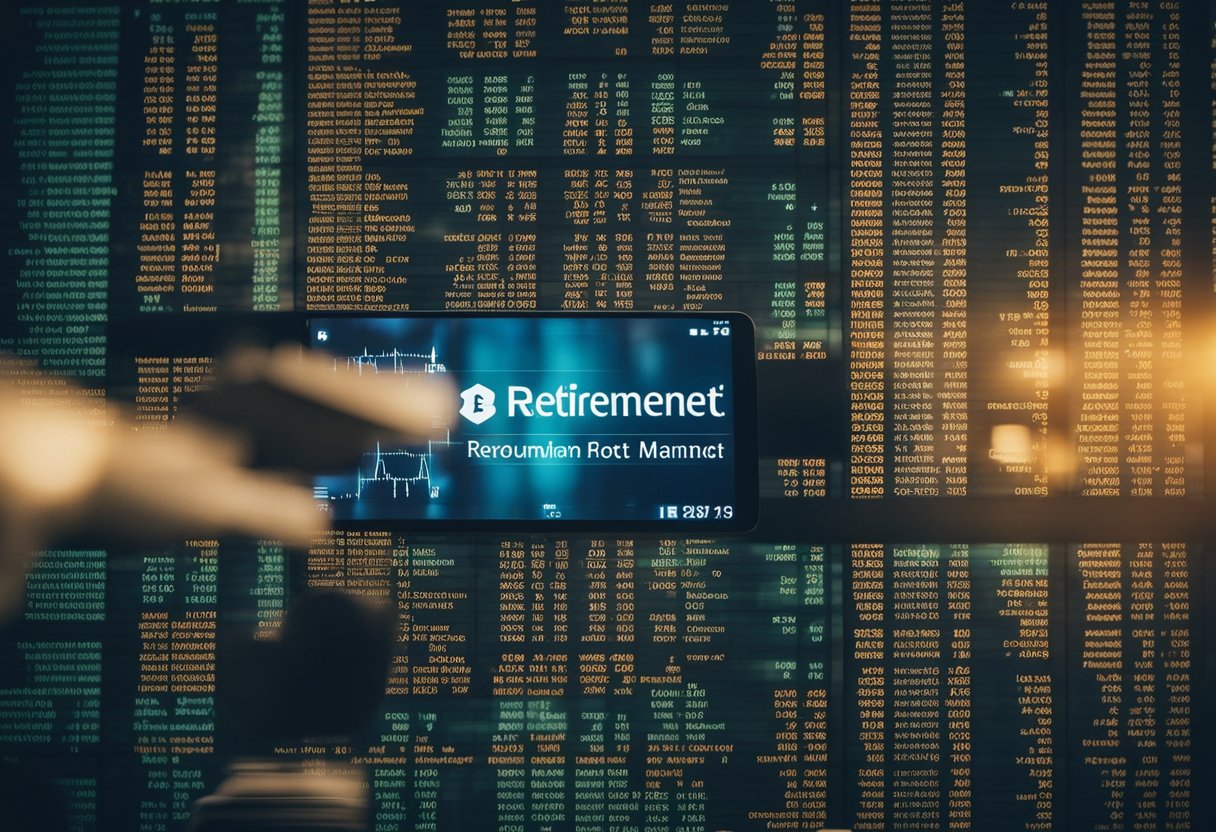Cryptocurrency retirement funds represent a burgeoning field, combining the innovation of digital assets with the long-term growth strategies of retirement planning. As traditional investment portfolios evolve to include more diverse assets, cryptocurrencies have become a significant talking point among both new and seasoned investors. Understanding the mechanisms behind incorporating cryptocurrencies into retirement strategies is critical, not only due to their potential high returns but also because of the unique risks associated with digital currency investment.

Navigating the complexities of cryptocurrency investment within retirement accounts demands a thorough comprehension of different account types, such as self-directed IRAs, and the specific tax implications cryptocurrencies carry. Investors are showing keen interest in the strategic inclusion of crypto assets, like Bitcoin or Ethereum, into their portfolios to possibly enhance growth over time while still keeping an eye on mitigating risks. Security measures and proper custody of digital assets are paramount, ensuring that the investors’ retirement funds remain protected.
Key Takeaways
- Cryptocurrency retirement funds merge digital asset innovation with traditional retirement savings strategies.
- Proper understanding and management of crypto’s unique risks and tax implications are crucial for investors.
- Security and diversification in cryptocurrency retirement portfolios are key to safeguarding and optimizing long-term growth.
Crypto 401(k) Options

With the advent of cryptocurrency, 401(k) plans are adapting to include this novel asset class. A crypto 401(k) allows participants to diversify their investment portfolio by including cryptocurrencies like Bitcoin and Ether, alongside traditional investments. Such accounts are often self-directed, giving individuals more control over their funds.
Employer-sponsored 401(k)s typically have a range of investment options, but the inclusion of cryptocurrency is not yet widespread. Employees interested in integrating crypto into their retirement planning might consider a self-directed 401(k). This option allows for traditional assets as well as alternative investments like crypto. It is important for investors to manage these accounts with a clear understanding of volatility and risk management strategies.
Individuals seeking to integrate cryptocurrencies in a retirement plan could also explore a Cryptocurrency IRA. A Cryptocurrency IRA can be either a Traditional IRA or a Roth IRA, offering different tax advantages. The former allows for tax-deferred growth, whereas the latter offers tax-free growth, with certain income limits applicable.
Here’s a brief overview of options within crypto retirement funds:
| Retirement Account Type | Description |
|---|---|
| Traditional 401(k) with Crypto Options | Employers may offer a selection of crypto investments within a traditional 401(k) plan, potentially with an employer match. |
| Self-Directed 401(k) | Permits a broader range of investments, including cryptocurrencies, with more personal control over the fund’s composition. |
| Cryptocurrency IRA | Either a Roth or Traditional IRA that includes cryptocurrencies like Bitcoin and Ether for potential higher returns. |
Investors should consider that while crypto assets can offer higher returns, they also present greater risk. As such, due diligence, and consultation with financial professionals is recommended before adjusting one’s retirement investment strategy. Given the evolving regulatory landscape, staying informed on changes that affect retirement accounts and cryptocurrency is crucial.
Understanding Cryptocurrency

Cryptocurrency is a digital or virtual form of currency that uses cryptography for secure financial transactions. It operates on a decentralized network of computers through a technology known as blockchain.
Bitcoin, introduced in 2009, is considered the first cryptocurrency, and it remains the most well-known and widely used. Following Bitcoin’s success, numerous other cryptocurrencies like Ether (Ethereum’s currency) and Litecoin have emerged, contributing to a diverse asset class.
Cryptocurrencies are known for their volatility. Prices can fluctuate widely, making them a volatile investment with both high risk and the potential for significant potential returns. This instability is due to various factors, including market sentiment, technological advancements, and regulatory news.
Despite the risks, the growth in cryptocurrency usage and its increasing integration into financial systems highlights its staying power as a digital asset. Investors considering cryptocurrencies as part of their retirement funds should keep in mind the following:
- Cryptocurrencies are inherently riskier than traditional investments.
- They can provide diversification in an investment portfolio.
- It’s essential to research and understand each asset class before investing.
| Key Terms | Description |
|---|---|
| Bitcoin | The first cryptocurrency. |
| Ether | Digital currency of the Ethereum network. |
| Volatility | Characteristic of rapid and significant price changes. |
| Digital Asset | A non-tangible asset that is created, traded, and stored in a digital format. |
| Asset Class | A group of investments that exhibit similar characteristics and market behaviors. |
Investors should invest only what they can afford to lose and consider speaking with a financial advisor who understands the intricacies of cryptocurrencies.
Introduction to Retirement Accounts

Retirement accounts serve as the cornerstone for individuals planning for their financial future. Individual Retirement Accounts (IRAs) are one of the most prevalent forms of retirement savings vehicles. They offer a way for individuals to set aside funds in a tax-advantaged environment. Among the different types of IRAs, Traditional and Roth IRAs are best known; the former allows individuals to make pre-tax contributions, which grow tax-deferred until withdrawal, while the latter permits post-tax contributions with the benefit of tax-free growth.
A Self-Directed IRA is an alternative that provides investors with a larger degree of control over their investment choices. Unlike a Traditional IRA, which typically limits investments to stocks, bonds, and mutual funds, a Self-Directed IRA allows for a diverse portfolio, including precious metals and alternative assets.
For those interested in integrating digital currencies into their retirement savings, customized IRAs such as a Coin IRA or Bitcoin IRA are gaining traction. They allow the inclusion of cryptocurrencies as part of the retirement investment mix, catering to investors who believe in the potential long-term growth of digital assets.
Investing in a blend of assets, including stocks, bonds, mutual funds, and even cryptocurrencies, can help in building a nest egg that is both robust and diverse. This diversification is crucial in navigating the volatile markets and ensuring a stable financial future. While the world of retirement accounts can be complex, informed decisions and strategic planning are essential in maximizing these investment tools for retirement.
Diverse Investment Strategies

Diverse investment strategies involve spreading an investment portfolio across various asset classes to manage risk and enhance potential returns. Investors often blend traditional assets such as stocks, bonds, mutual funds, and exchange-traded funds (ETFs) with alternative investments like real estate, aiming for a diverse mix of assets.
A financial advisor can guide the allocation of assets to match an individual’s savings goals and appetite for risk. They might suggest a selection of pre-selected funds that cater to a variety of risk levels and include a wide range of investment options.
Investing in cryptocurrency retirement funds can add a new dimension to diversification, potentially increasing the upside potential of a portfolio. However, due to their volatile nature, a conservative approach is often recommended when incorporating cryptocurrencies.
The table below shows a simplified asset allocation for a balanced investment portfolio:
| Asset Class | Allocation Percentage |
|---|---|
| Stocks | 50% |
| Bonds | 20% |
| Mutual Funds | 10% |
| ETFs | 10% |
| Real Estate | 5% |
| Cryptocurrencies | 5% |
Balanced diversification ensures exposure to a variety of investment channels, leveraging different market conditions. It is critical to regularly assess and adjust the portfolio to maintain a healthy balance, aligning it with ongoing financial goals and economic changes.
Cryptocurrency Tax Implications

Investments in cryptocurrency within retirement funds carry unique tax implications that necessitate careful management to maximize potential benefits.
Managing Crypto Taxes
Tax Treatment of Cryptocurrency
Cryptocurrency is treated as property by tax authorities such as the Internal Revenue Service (IRS). This treatment means that capital gains taxes apply to any profit from the sale or exchange of cryptocurrency. The tax rate varies based on how long the investor holds the cryptocurrency: short-term for assets held under a year and long-term for those held longer.
- Short-term gains are taxed as ordinary income at standard rates.
- Long-term gains benefit from reduced tax rates, potentially providing significant savings.
Retirement Funds and Tax Benefits
Retirement funds that invest in cryptocurrency may provide tax advantages.
- Tax-Advantaged Accounts: Contributions to accounts like traditional IRAs may be tax-deductible, and the investments grow tax-deferred until retirement.
- Tax-Free Growth: Certain accounts like Roth IRAs offer tax-free growth, meaning that withdrawals after retirement are not subject to taxes, including the gains from cryptocurrency investments.
It is critical to consult a tax professional to navigate these rules and report cryptocurrency transactions properly on tax returns. They ensure compliance with tax laws while optimizing the potential tax benefits associated with cryptocurrency retirement funds.
Choosing a Crypto Investment Platform

When an investor is considering a cryptocurrency retirement fund, selecting the right platform is crucial. There are various types of platforms, including brokerage firms, cryptocurrency exchanges, and custodians that offer crypto vault services.
- Brokerage Firm: A brokerage firm typically facilitates the buying and selling of cryptocurrencies, offering a straightforward user interface and sometimes providing access to financial advisors for guidance.
- Cryptocurrency Exchange: An exchange is a platform where buyers and sellers trade cryptocurrencies. They offer a wide range of currencies and more control over trading decisions.
- Custodian: Custodians store cryptocurrencies securely, often using vaults, and ensure compliance with regulatory standards.
Consider the following when choosing a platform:
| Factor | Description |
|---|---|
| Fees | Check both transaction fees and any other associated service charges. |
| Security | Ensure robust security measures, like cold storage vaults, are in place. |
| Accessibility | Look for a user-friendly interface and access to a financial advisor. |
Also, take into account the availability of exchange-traded funds (ETFs), which can diversify investments without directly holding the cryptocurrency. It’s essential to use a platform that aligns with one’s investment strategy and provides adequate support and advice as needed.
Crypto Security and Custody

Investors prioritize secure management for their crypto assets in retirement funds. Custodial solutions geared towards cryptocurrencies are critical to safeguard these digital investments.
Secure Storage Solutions
Crypto Wallets: They serve as the primary means of storing digital assets securely. Wallets are divided into two categories: hot wallets (online) and cold wallets (offline). The choice between them hinges on the balance between convenience and security.
- Hot Wallets are connected to the internet, facilitating easy transactions. However, they may be more susceptible to security breaches.
- Cold Wallets offer enhanced security by storing assets offline, significantly reducing the risk of cyber theft.
Custodians: These are entities that hold and secure the digital assets for investors. Reputable custodians possess robust security measures and insurance policies to manage and mitigate risks.
- Security Measures: Include multi-signature authentication, regular audits, and anti-phishing protocols.
- Insurance: Some custodians provide insurance that may cover asset loss due to security breaches, though typically not to the extent of the Federal Deposit Insurance Corporation (FDIC) or Securities Investor Protection Corporation (SIPC).
Regulatory Compliance: Custodians often need to comply with stringent regulations, maintaining high security and operational standards to protect investors’ digital assets.
Risk Management: Maintaining the safety of cryptocurrency holdings goes beyond physical storage. It includes developing a comprehensive risk management strategy that encompasses:
- Access Controls: Limiting who can authenticate transactions and access the funds.
- Regular Security Updates: Keeping software up to date to defend against new threats.
- Employee Training: Ensuring that all personnel are knowledgeable about security best practices.
The integrity of a retirement fund’s cryptocurrency investment is greatly influenced by the security measures and custody solutions in place. They don’t just protect the monetary value but also fortify trust in the digital currency sphere.
Advantages of Self-Directed IRAs
Investors seeking broader investment options often turn to Self-Directed IRAs (SDIRAs). These retirement accounts differ from traditional or Roth IRAs by allowing investment in a variety of alternative assets. Here are the key benefits:
1. Diversification: SDIRAs allow the inclusion of real estate, precious metals, and private placements, providing diversification beyond stocks, bonds, and mutual funds.
2. Control Over Investments: Investors have greater control over their retirement savings and investment decisions, as they can select and manage their assets directly.
3. Tax Advantages:
- Traditional SDIRA contributions can be tax-deductible, with taxes deferred until withdrawal.
- Roth SDIRA contributions are made with after-tax dollars, but qualified withdrawals are tax-free.
4. Access to Private Markets: They grant access to private placements and other investments not available through conventional IRAs.
5. Potential for Higher Returns: Although riskier, alternative assets can provide the potential for higher returns compared to traditional investment options.
It is important to note that a custodian is required to hold the IRA assets on behalf of the investor, ensuring the investments comply with IRS regulations. Investors must perform due diligence when selecting a custodian and understand the responsibilities involved in managing a self-directed IRA.
Assessing Risks and Growth
When considering cryptocurrency as part of a retirement fund, it is essential to understand the inherent risks and growth potential. Cryptocurrencies are known to be highly volatile; the value of digital assets can fluctuate widely in a very short period, which differs substantially from traditional stocks and safer investments.
Investors should have a clear investment strategy that takes into account their risk tolerance and retirement timeline. Cryptocurrencies can be seen as risky investments and should be balanced with more stable assets to mitigate potential losses.
Real-world utility of a cryptocurrency is an important factor in assessing its long-term viability and growth potential. Those with established uses and adoption may present lower risks compared to purely speculative tokens.
- Risk Consideration Checklist:
- Understand the volatility of cryptocurrency markets
- Align crypto investments with overall risk tolerance
- Balance crypto with traditional retirement assets
It’s important for investors to gauge the growth potential of cryptocurrencies by keeping an eye on emerging trends and technological advancements that could increase the real-world utility of specific coins or tokens.
- Growth Assessment Insights:
- Monitor the adoption rates of cryptocurrencies
- Analyze market trends and technological innovation
- Stay informed about regulatory changes
Investors should recognize that while growth opportunities exist, they come with a proportionate level of risk. Diversification among asset classes and within the cryptocurrency domain itself may help in managing those risks.
Evaluating Fees and Charges
When considering a cryptocurrency retirement fund, one must carefully assess the various fees and charges involved. Transaction fees are often the most visible costs and can vary significantly between different cryptocurrencies and trading platforms. These fees are charged for the processing of transactions and are critical for the security and maintenance of the blockchain network.
Setup fees may also be applicable when initiating a retirement fund. These are one-off charges levied to establish the account. It’s important to compare these across different providers to ensure they are getting a competitive rate.
The cumulative impact of high fees over time can considerably reduce the growth of retirement savings. As such, it’s crucial to understand all fee structures associated with their chosen fund. Below is a breakdown that investors should consider:
- Monthly/Annual Management Fees: These are ongoing charges for the management of the fund, typically calculated as a percentage of the total investment.
- Performance Fees: Some funds may charge a fee based on the fund’s performance, aligning the interests of the managers with the investors.
- Withdrawal Fees: Fees may be incurred when withdrawing funds from the retirement account. This is especially pertinent if an investor plans to make frequent withdrawals.
Investors must request a detailed fee schedule from their provider and consider the long-term implications of these charges on their investment. Analysts recommend focusing on funds with transparent and reasonable fee structures to maximize retirement savings growth.
Planning for the Long Term
When considering cryptocurrency as an option for retirement savings, an individual must assess their long-term financial goals. Diversifying a retirement investment portfolio can help balance risk and might include traditional stocks, bonds, and real estate, alongside newer asset classes like cryptocurrency.
- Growth: Cryptocurrencies may offer potential for long-term growth, but they come with high volatility. Investors should weigh the growth prospects against their own risk tolerance.
- Income: Unlike traditional income-generating assets, cryptocurrencies typically do not offer dividends. Instead, investors may rely on appreciation for returns.
Engaging a financial advisor can be beneficial. Advisors with expertise in both traditional retirement planning and the evolving cryptocurrency market can provide invaluable guidance. They can assist individuals in:
- Strategizing: Aligning crypto investments with other retirement income sources, such as social security or pensions.
- Allocating: Determining an appropriate crypto allocation within the broader investment portfolio.
Investors should do a thorough solvency analysis of crypto retirement funds, considering market trends and historical data, to determine the potential for long-term growth. An expertly crafted retirement plan takes into account the mutable nature of cryptocurrencies. It is prudent for individuals to remain informed and adapt their strategies as the market evolves.
Frequently Asked Questions
Cryptocurrency retirement funds are a modern investment strategy for long-term wealth growth. The following FAQs address key aspects of incorporating digital currencies into retirement planning.
How do Bitcoin IRAs work?
Bitcoin Individual Retirement Accounts (IRAs) operate similarly to traditional IRAs but allow for the inclusion of Bitcoin as part of the retirement portfolio. Investors hold a self-directed IRA and a qualified custodian creates and manages their account, facilitating the investment in Bitcoin.
What are the best practices for including cryptocurrency in a retirement portfolio?
Investors should diversify their retirement portfolio when including cryptocurrency to manage risk effectively. It is advisable to limit exposure to a small percentage of the total portfolio value and regularly review and adjust holdings in response to market changes.
What options are available for investing in a Crypto ETF within a retirement account?
Crypto ETFs (Exchange Traded Funds) provide a way for retirement accounts to invest in cryptocurrency indirectly. These funds are available on many mainstream investment platforms and can be incorporated into existing retirement accounts, subject to the investment options offered by the account provider.
What are the procedures for purchasing Bitcoin through a Roth IRA?
To purchase Bitcoin through a Roth IRA, an investor must first establish a self-directed Roth IRA with a firm that permits cryptocurrency investments. The investor then transfers funds and directs the custodian to purchase Bitcoin on their behalf, adhering to the IRS regulations for Roth IRAs.
Which companies allow for cryptocurrency options in 401(k) plans?
Several companies offer cryptocurrency options within 401(k) plans. Providers such as Fidelity Investments and Charles Schwab have taken steps toward integrating digital currencies, allowing plan participants to include them as part of their investment strategies.
Are there any penalties or implications for withdrawing from a Bitcoin IRA?
Withdrawing from a Bitcoin IRA before the age of 59½ typically results in a 10% early withdrawal penalty, in addition to income tax on the distribution. The same rules apply as with traditional IRAs, and investors must comply with IRS guidelines regarding retirement accounts.
RELATED VIDEO PROGRAM
Crafting a Cryptocurrency-Centric Retirement Approach
Stacie Olivares, a Member of the Federal Retirement Thrift Investment Board, engages in a conversation with Emily Chang and Bloomberg’s Sonali Basak. They delve into the intersection of cryptocurrency and retirement, exploring the influence of the crypto market downturn on pension funds. Additionally, the discussion touches upon the evolving landscape of retirement investing, considering generational shifts in approach.




